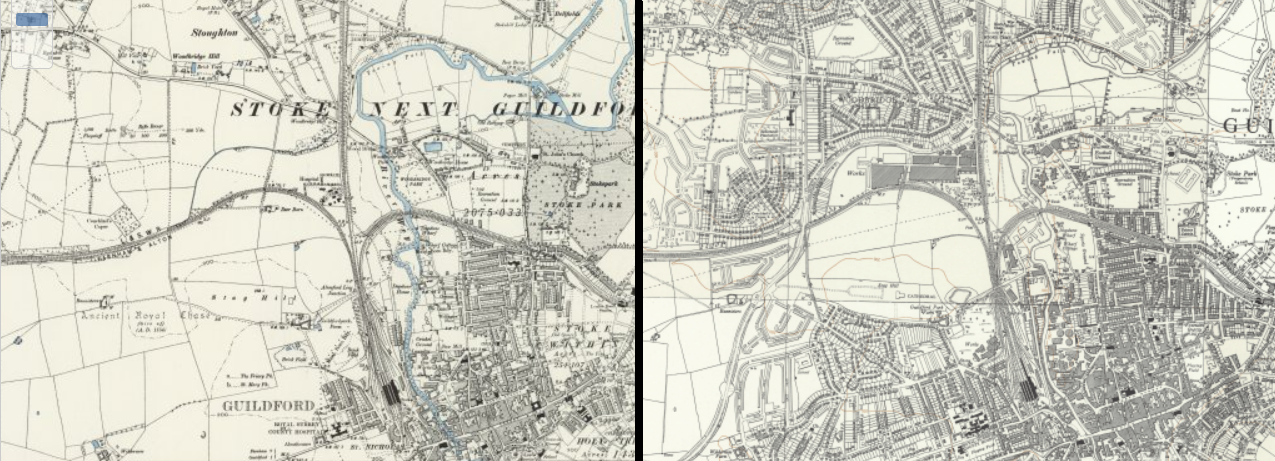Many analogies to the Matrix red pill have been made in the past ten years or so, mostly in the realm of politics, political economy and culture. From about 2016 onward, an explosion of many new “pills” of realisation came onto the scene. At times, I thought too many were entering the market that it might end up rendering the whole pill analogy rather diluted and obsolete. But I still think it is useful, and there is a new issue for which I believe the pill analogy is particularly apt which I am going to demonstrate.
I grew up in Guildford, a suburban town in the county of Surrey in England, bordering the south west of Greater London. It is a town with a lot of history, with the main highstreets in the centre of the town, and some of the lesser connective streets, dating back to Saxon times. The railways running through it have been around about as long as railways have been around in Britain, and are still used today. However, like many towns and cities in Britain and the wider Western world, it soon became subject to the modern suburbia planning model. Before the war, most of Guildford’s features were concentrated close to its centre. Housing was in walking distance from the main areas of communal activity. After the war, housing started to be built more expansively on the outer regions of the town, creating wide areas of pure residential.

Growing up, there seemed no immediate issue to me that we would drive to do almost anything outside our house. Mostly because the issue with it would likely be mitigated by how we did know plenty of people in the area. But there were events in my life after I turned 21 that were a bit of an epiphany for me. During my undergraduate studies, I lived in a picturesque cobbled street in a small suburban settlement Headingley, on the outskirts of Leeds. I lived within a five minute walking distance of the full variety of local features, the pubs, bars, shops, restaurants, the church, the village hall etc. The experience of existing in such a pedestrian environment was a strange and rather uncomfortable realisation about how rather silly that these settlements of humans where we are all vehicular distances apart really are. It almost felt like a kind of righteous indignation. Almost as if I had taken a pill and become awakened to the flawed realities around me!



With the subsequent mass-production of the automobile, planning of towns became more spacious to respect it as a primary mode of transport. Hence, a justification came for large expansive areas of residential buildings with very little intermediacy or seasoning with communal features and amenities (such as those mentioned above) that are within a reasonable walking distance. Such a reasonable walking distance I personally believe should not commonly exceed 10 minutes. Whilst the specific position of the threshold for reasonable walking distance might vary, such a boundary does definitely exist. I do not believe the cause of this phenomenon in town planning can just solely be laid at the mere existence of mass-produced cars. There existed plenty of explicit and influential ideological factors of a new consensus in growth and development that went into explicit government policy. Neither is it that we ought to go full Luddite and proceed to denounce the car entirely. Human settlements tend to cluster, with open space left between them, which the car is perfectly useful for bridging the distance between. But it was a mistake for it to be factored so strongly into a model of settlement planning and internal movement of distinct settlements themselves.
People often claim that pedestrian-oriented layouts tends to be more common in towns and cities of central to southern Europe (and a few northerly places too), and it seems like a worthwhile endeavour to be looking to such places for inspiration. I can personally attest to the desirable layouts of cities and towns in the likes of Southern France and Tuscany.
In order for more effectual change to occur, we ought to be a little bit more than casually grumbling over the dullness of unenriched suburban expansive residential seas and instead take the Pedestrian variety of the red pill. This isn’t really an issue that ought to have a more gradual range of opinion, but instead one with more discrete understandings where the issue is – a majority of the time – one of either quite important or rather immaterial. The suburbs don’t exist in the way they do by complete accident, but to a significant extent by a conscious decision that ought to be consciously reversed.
In the meantime, I am hoping to move out of Guildford for its unfortunate vehicular structure that I have sadly become too aware of now to dismiss. There is a town about 20 minutes down the A31 which seems to be one of the most ideal and convenient pedestrian settlements in my county, if not the whole of the United Kingdom. It’s still early stages, and there are a few issues with finances that I still need to assess. But it is the goal; to – as they say – “vote with one’s feet.” And it might ultimately be a raised awareness of the benefits of the Pedestrian that might drive trends in demand and hence trends in town planning from higher places.
